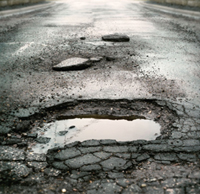Various alternatives have been proposed to the familiar, primary mechanisms—fuel taxes, auto registration fees and property taxes—for funding transportation infrastructure. Each approach aimed at stemming the decline in revenue for roads and bridges has its selling points, but also downsides that make implementation problematic. Here’s a rundown of ideas for getting motorists and other beneficiaries of the highway system to pony up a little more for its support.

Open-road tolling
This pay-as-you-drive strategy for dense, urbanized corridors is more common on the East and West coasts, although there are examples in the district, such as the toll lanes on I-394 and I-35W in the Twin Cities. Instead of depositing coins at a toll booth, motorists pay electronically via radio-frequency identification or license-plate imaging systems. Tolls can be collected with the intent of reducing congestion, as on I-394, or raising funds directly from highway users for construction and ongoing maintenance. Government agencies usually operate toll roads and bridges, but they can also be owned and run by investor-owned companies. (About 10 states have opened private toll roads over the past 15 years.)
In the district, the Transportation Development Association of Wisconsin, an advocate for highway and transit investment, has proposed open-road tolling on I-94, I-90 and I-43—if a federal ban on converting freeways to toll ways can be overturned.
Legalities aside, there are other reasons why open-road tolling may not catch on in the district. Many motorists view tolls as onerous—voters in eastern states have rebelled against even slight increases in charges on existing toll roads. And there’s a risk that tolling authorities will charge too much, inducing too many drivers to take other routes in order to avoid the toll. “It’s a waste of resources to [overcharge], and it pushes people onto other roads that are less safe and more congested,” said David Levinson, a professor at the University of Minnesota’s Center for Transportation Studies.
Vehicle mileage taxes
If motor fuel consumption is expected to fall due to higher fuel efficiency standards (federal rules call for the national auto fleet to average 35 miles per gallon by 2020) and more electrically powered vehicles, why not tax miles instead of gallons? A vehicle miles traveled (VMT) tax potentially could generate more funds for roads by broadening the tax base; after the recession, nationwide VMT is expected to resume its upward trajectory even as fuel use wanes.
 Adopting some sort of VMT tax in the future probably is inevitable, because of growing numbers of hybrid electric and plug-in electric vehicles. A congressional transportation finance commission concluded in 2009 that “the most viable approach to efficiently fund federal investment in surface transportation in the medium to long run will be a user charge system based more directly on miles driven.” The state of Oregon recently completed a pilot VMT program that used Global Positioning System technology to track mileage.
Adopting some sort of VMT tax in the future probably is inevitable, because of growing numbers of hybrid electric and plug-in electric vehicles. A congressional transportation finance commission concluded in 2009 that “the most viable approach to efficiently fund federal investment in surface transportation in the medium to long run will be a user charge system based more directly on miles driven.” The state of Oregon recently completed a pilot VMT program that used Global Positioning System technology to track mileage.
But many experts believe that it’s too early to introduce a VMT tax. Gasoline or diesel fuel still powers virtually all vehicles on U.S. roads. Moreover, fuel taxes are inexpensive to collect and help to reduce pollution and greenhouse warming by penalizing consumption. A mileage tax, on the other hand, is likely to be expensive to administer and would remove a direct incentive to curtail fuel use.
A VMT tax also raises privacy concerns, because of those onboard GPS devices, notes Robert Noland, a transportation expert at Rutgers University. “If the public doesn’t want a gas tax, how come they’re going to go for a fancy scheme where you’re taxing VMT through electronic and, what would appear to be, far more intrusive measures?”
Land value taxes
Investments in highway infrastructure such as a rebuilt freeway interchange or new bridge often increase the value of adjacent private land by improving access to job centers, schools and other destinations. Land value taxes capture some of this increased valuation that otherwise would entirely benefit landowners.
Typically, a land value tax assesses land and buildings separately at different rates; vacant land is taxed at a higher rate than structures to encourage development. Use of land value taxes has been limited in the United States, partly because of state control of local taxing authority. But a municipality or county conceivably could levy a land tax to finance road or bridge projects, extracting a contribution from landowners before, during or after construction.
However, accurately assessing the added value created by a particular highway project may prove difficult, and a land tax isn’t likely to sit well with property owners. “The argument for this is theoretically sound,” Levinson said. “Politically, it’s a little more challenging.”
Other strategies that capture the value of highway-aided real estate development: tax increment financing (creating a TIF zone around a freeway interchange, for example); special assessments on property owners; and joint development, in which a private entity contributes financially to public roads serving new real estate development.
With the exception of a VMT tax, these innovative financing tools are best suited for urban areas with a lot of traffic and real estate development. Open-road tolling and value-capture techniques are a non-starter for the district’s vast network of rural roads. However, other funding mechanisms—all forms of taxation—could support rural highways and bridges. One proposed solution, at least for the short term, is to index motor fuel taxes to inflation, so that revenues retain their buying power over time. The Wisconsin Legislature adopted gas tax indexing in the early 1980s, but dropped the practice in 2006.
Other ideas for boosting highway funding include a motor fuel sales tax (taxing the value of fuel instead of the quantity), taxes on vehicle carbon emissions and a portion of general sales taxes applied to transportation.





